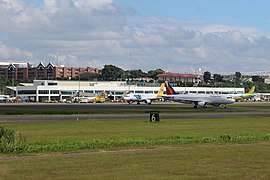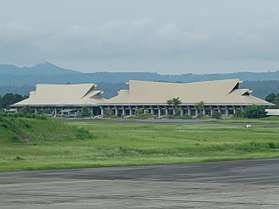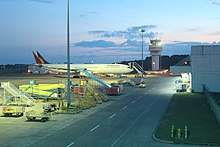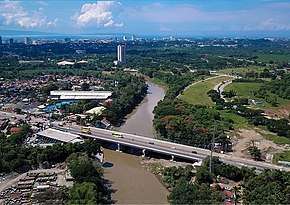Francisco Bangoy International Airport
Francisco Bangoy International Airport (Cebuano: Tugpahanang Pangkalibutan sa Francisco Bangoy), also known and still commonly referred to as Davao International Airport (IATA: DVO, ICAO: RPMD), is the main airport serving Davao City in the province of Davao del Sur and Davao Region in the Philippines. It is the busiest airport in the island of Mindanao and the third busiest in the Philippines after Ninoy Aquino International Airport in Manila and Mactan–Cebu International Airport in Lapu-Lapu, Cebu. The airport has a single 3,000-meter precision runway.
Francisco Bangoy International Airport Tugpahanang Pangkalibutan sa Francisco Bangoy | |||||||||||
|---|---|---|---|---|---|---|---|---|---|---|---|
 The airport in January 2018 as viewed from across the runway. | |||||||||||
| Summary | |||||||||||
| Airport type | Public | ||||||||||
| Owner | Civil Aviation Authority of the Philippines | ||||||||||
| Operator | Davao International Airport Authority | ||||||||||
| Serves | Davao City and Davao Region | ||||||||||
| Location | Catitipan, Barangay Buhangin, Davao City, Philippines | ||||||||||
| Hub for | |||||||||||
| Elevation AMSL | 29 m / 96 ft | ||||||||||
| Coordinates | 07°07′31″N 125°38′45″E | ||||||||||
| Map | |||||||||||
.svg.png) DVO/RPMD Location in the Philippines | |||||||||||
| Runways | |||||||||||
| |||||||||||
| Statistics (2018) | |||||||||||
| |||||||||||
Source: eFOI[1] | |||||||||||
A new terminal replaces the previous airport terminals, which lie just across it, in handling both domestic and international flights operating to and from Davao. The modern facility is designed to handle approximately 2 million passengers annually and 84,600 metric tons of cargo annually. The added capacity is also complemented by the latest navigational, security, and baggage handling equipment.
The modernization and upgrading of the airport facilities aims to make Davao as a hub for tourism and foreign investment in the region. Development was funded by a forty million-dollar loan from the Asian Development Bank, co-financed by the European Investment Bank for twenty-five million ECUs, and through budgetary allocations from the government. The total cost of the project amounted to $128 million.
After almost a decade, the new terminal was finally inaugurated on December 2, 2003. Initial construction began in 2000 while plans for construction were announced in 1992.
On November 12, 2007, Cebu Pacific announced this airport as its third hub.[2]
Philippine Airlines, the country's flag carrier, announced this airport as its third hub on March 26, 2018.[3]
The Republic Act 11457, also known as the Davao International Airport Authority charter, was signed by President Rodrigo Duterte on August 30, 2019. This law creates and establishes the Davao International Airport Authority which will be handling all airports in Davao Region, including the Francisco Bangoy International Airport in Davao City.[4]
History

Francisco Bangoy International Airport began operations in the 1940s with a donation of land in Barangay Sasa, located in the Buhangin district of Davao City, by Don Francisco Bangoy, the patriarch of an influential family who later served as the city's congressman. At the time it began operation, the airport merely consisted of a 1,200-meter unpaved grass runway and quonset huts serving as terminal buildings. At the time, and throughout much of the 1940s and 1950s, both Philippine Airlines and the Philippine Air Force provided air service to the city.[5]
By 1959, the complex consisted of a small control tower and several low-rise buildings. Right of way and access to the terminal buildings and the airport was improved through further donation of land by Paciano Bangoy during the latter stages of his gubernatorial term. A new terminal designed by Filipino architect Leandro Locsin, with a capacity of one million passengers, was constructed in 1980 and the runway was progressively extended from its original length of 1,200 meters to its current 3,000 meters. Both projects were funded during the term of then-Congressman Manuel Garcia, whose congressional district covers the airport perimeter.[5]
Rapid growth at the airport precipitated the construction of a ₱15 million interim international terminal beside the airport's then-existing terminal,[5] and then eventually a new, larger terminal building which would consolidate the two existing terminals. In planning since 1992, construction began in 2000 and subsequently inaugurated on December 2, 2003, with a capacity double that of the old airport terminal. The construction of the new P2.7 billion building was funded by both the Asian Development Bank and the European Investment Bank.[5]
On March 4, 2003, a bomb exploded in the waiting shed outside the old terminal building, killing 21 people. At least 145 others were injured when the bomb went off.[6]
On June 2015, the Mindanao Development Authority plans to turn the 1980–2003 airport terminal into a trade and cultural museum. The plans are still being studied.
Statistics
Data from Civil Aviation Authority of the Philippines (CAAP).[1]
Passenger movements
|
Aircraft movements
|
Cargo movements
An em dash (—) is used when data from CAAP is not available. |
Structure
Terminal
.jpg)
The ₱2.7 billion passenger terminal is a Malay architecture-inspired building which is four times larger than the old terminal. It is a two-level terminal building with an area of approximately 17,500 square metres (188,000 sq ft). It is also fully computerized, more secure and has more commercial spaces for concessionaires at approximately 9,000 square metres (97,000 sq ft) of gross leasable area. It has four (4) jetbridges for passenger boarding. Moreover, it also has a Flight Information Display System and closed-circuit television system complementing the terminal's security system.
The terminal has 14 domestic and 14 international check-in counters that can handle a steady flow of passenger traffic. The Check-in counters are equipped with electronic weighing scales and conveyors and its baggage handling system is also computerized. It also has 2 arrival areas, for domestic and international with 2 baggage conveyors each. The Cargo Terminal Building covers almost 5,580 square metres (60,100 sq ft) and can handle up to 84,600 metric tons (83,300 long tons; 93,300 short tons) of cargo a year.
Runway

The airport has a single 3,000-metre (9,800 ft) long runway by 45-metre (148 ft) wide that can handle basically all passenger wide-bodied aircraft, including the Airbus A380. Complementing the runway are two (2) turning pads at each end of it, which help aircraft make a backtrack. The installation of a new instrument landing system (ILS) for both Runways 05 and 23 upgraded its compliance to International Civil Aviation Organization (ICAO) operating category-Precision Approach Category 1. It can accommodate 8 to 10 aircraft landings per hour, depending on size and has the equivalent 9 gate holding areas for those aircraft. The airport has also 2 dual access taxiway. Taxiways A3 and A4 are used to access the new ramp and terminal; taxiways B and C are used for access to the old airport ramp.[7]
The largest aircraft to land at the Francisco Bangoy International Airport is an Antonov An-124. The Antonov An-124 is the fourth largest plane in the world, next to the Boeing 747-8.
Other structures
Besides the main terminal building, there are also new support facilities like the Administration Building, Airfield Maintenance Building, Central Plant Building, Hangar for Military and Training aircraft and Fire/Crash/Rescue Building. It has an 800-slot car parking area and 4 slots for shuttle buses. It has a 3-megawatt (4,000 hp) standby power generator.
Future Development
A Philippine Tourism Development Plan was released by the Department of Tourism, which includes Davao International Airport:[8] Bidding for the construction of a parallel taxiway has been completed and will start construction soon.[9]
Project 4: Upgrade
This project comprises the following tasks:
- In January 2017, the bidding started for the Rehabilitation and Expansion of Davao International Airport. It includes building a new passenger terminal and a second runway being considered. On May 22, 2017, Sec. Tugade decided that the funds will be from Overseas Development Assistance (ODA).
- Rehabilitate existing terminal building and improvement of comfort rooms; expansion of existing terminal building, expansion of apron and vehicle parking area; consultancy services for the advance engineering, detailed engineering design and environmental impact assessment Study for Davao Airport Project; and construction of parallel taxiway and initial site acquisition for new airport site.
- Improvements to enhance the safety, security, access, passenger and cargo movement efficiency, and operational efficiency.
Airlines and destinations
As of June 8, 2020, some flights have resumed, with particular schedules of operations mandated by the City Mayor. However, due to cancellation of flights following the COVID-19 pandemic, this list is no longer current and destinations are subject to change without prior notice.[10]
| Airlines | Destinations |
|---|---|
| Cathay Dragon | Hong Kong |
| Cebu Pacific | Bacolod, Cebu, Clark, Iloilo, Manila, Singapore, Tagbilaran, Zamboanga |
| Cebu Pacific operated by Cebgo | Cagayan de Oro |
| Garuda Indonesia | Manado |
| Philippine Airlines | Cebu, Manila |
| Philippine Airlines operated by PAL Express | Cebu, Clark, Manila, Siargao, Tagbilaran, Zamboanga |
| Philippines AirAsia | Cebu, Clark, Manila |
| Qatar Airways | Doha |
| SilkAir | Singapore1 |
| XiamenAir | Quanzhou |
^Note 1 : This flight makes an intermediate stop in Cebu before continuing on to the listed destination. However, it has no rights to transport passengers solely between Davao and Cebu.
Access and transportation
Road

The airport is connected to the city via the Carlos P. Garcia National Highway. The 4-laned La Verna-Mamay Bypass Road was constructed and finished in 2017 near the airport to decongest traffic going from Mamay road to the airport and beyond and vice versa, by avoiding the usually busy intersection of Mamay Road and the Carlos P. Garcia National Highway. To avoid widening a road, which would displace houses and creep onto the airport's site, the road splits into two for 600 meters then merges back. It has a length of 1.7 kilometers, and is able to accommodate 1,000 vehicles per day.[11]
The planned Davao City Expressway will further connect the airport to the city via a diamond interchange. If it goes according to plan, the entire project will be completed in 2026.[12]
Incidents
- On April 19, 2000, Air Philippines Flight 541, a Boeing 737-200 en route from Manila to Davao crashed near the airport killing 131 people.[13][14]
- On the night of August 25, 2008, a Philippine Air Force Lockheed L-100 Hercules bound for Iloilo City crashed into Davao Gulf shortly after take off from Davao International Airport. The aircraft sank 800 feet into the gulf. The incident killed nine crew members plus two Philippine Army soldiers.[15][16] After several days of a search-and-retrieval operation, the wreckage was found with the help of a US Navy ship, the USNS John McDonnell.[17]
- On June 2, 2013, Cebu Pacific Flight 971 (registration number RP-C3266) carrying 165 passengers inbound from Manila, overshot the runway during heavy rain. There were no fatalities, however the plane was heavily damaged.[18] The damaged aircraft was moved to the old airport terminal for the investigation and parting.
See also
- List of airports in the Philippines
- Tallest buildings in Davao City
References
- Civil Aviation Authority of the Philippines (July 23, 2018). "Yearly Passenger, Cargo and Aircraft Movements of all airports in the Philippines 1997-2017". Republic of the Philippines - Freedom of Information Portal. Retrieved August 13, 2018.
- "Cebu Pacific to make Davao its 3rd hub" (Press release). Cebu Pacific. November 12, 2007. Archived from the original on November 17, 2007. Retrieved November 12, 2007.
- Cayon, Manuel (March 26, 2018). "Hong Kong, Bangkok eyed for next foreign route of PAL's Davao hub - Manuel Cayon". BusinessMirror.
- "Duterte approves creation of Davao International Airport Authority". Philippine Daily Inquirer. September 10, 2019. Retrieved September 14, 2019.
- Ajero, Antonio M. (December 1, 2003). "Nonoy Garcia, Elias Lopez and other airport tales". SunStar. Sun.Star Davao. Archived from the original on December 21, 2003. Retrieved December 14, 2008.
- "Philippines airport bomb kills 18 – March 4, 2013".
- "Airports – Davao Int'l Airport". CAAP. Archived from the original on August 29, 2012. Retrieved September 1, 2012.
- "Formulation of the Philippine National Tourism Development Plan 2011–2016" (PDF). Department of Tourism – Philippines. Archived from the original (PDF) on March 4, 2016. Retrieved September 1, 2012.
- "Signed Contract- Davao IADP.pdf". Google Docs. Retrieved January 4, 2020.
- Pelayo, Marje (June 8, 2020). "Davao Int'l Airport resumes domestic flights June 8". UNTV. Retrieved June 11, 2020.
- June 29, Rudolph Ian Alama Published on; 2018. "New bypass road opens in Davao City". Philippine Information Agency. Retrieved November 30, 2019.CS1 maint: numeric names: authors list (link)
- "Project description" (PDF). eia.emb.gov.ph. 2019. Retrieved March 23, 2020.
- "Air disaster timeline". BBC. November 30, 2007. Retrieved July 16, 2012. Cite journal requires
|journal=(help) - "Accident description". Aviation Safety Network. May 19, 2000. Retrieved July 16, 2012.
- "Hercules goes down in Davao Gulf; 9 missing". Philippine Daily Inquirer. August 27, 2008. Archived from the original on October 24, 2008. Retrieved July 16, 2012.
- Ranter, Harro. "ASN Aircraft accident Lockheed L-100-20 Hercules 4593 Barangay Bukana, San Pedro Extension, Davao City". aviation-safety.net. Retrieved May 29, 2017.
- "US Navy ship to help locate crashed C-130". Philippine Daily Inquirer. Cebu Daily News. August 30, 2008. Archived from the original on November 22, 2008. Retrieved July 16, 2012.
- Manlupig, Karlos (June 2, 2013). "Cebu Pacific plane overshoots Davao airport runway". Rappler. Retrieved June 3, 2013.
External links
- – AECOM
- World Aero Data – Francisco Bangoy International Airport (DVO) Details
- What's On & Expat Magazine, June 18, 2006 – Upgraded Davao City International Airport Is Ready for More Passengers and Bigger Aircraft
- Current weather for RPMD at NOAA/NWS
- Airport information for RPMD at World Aero Data. Data current as of October 2006.Source: DAFIF.
- Airport information for DVO / RPMD at Great Circle Mapper. Source: DAFIF (effective October 2006).
- Accident history for DVO / RPMD at Aviation Safety Network
